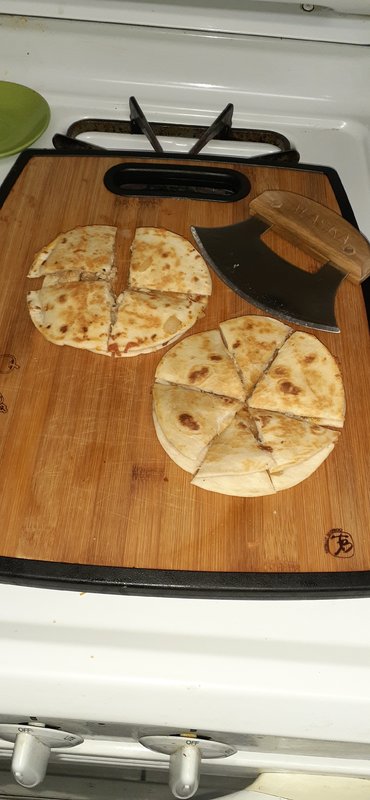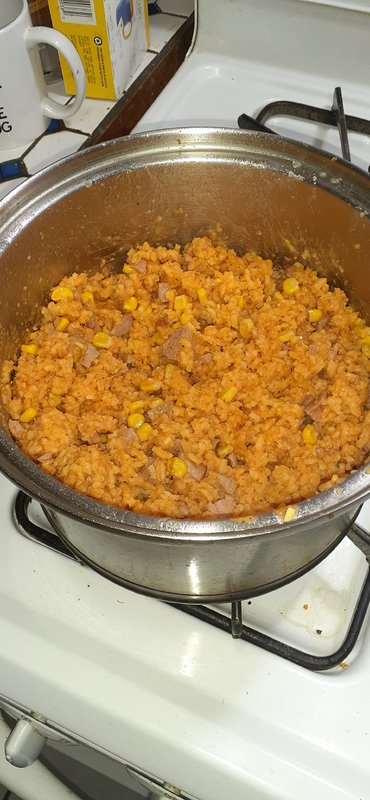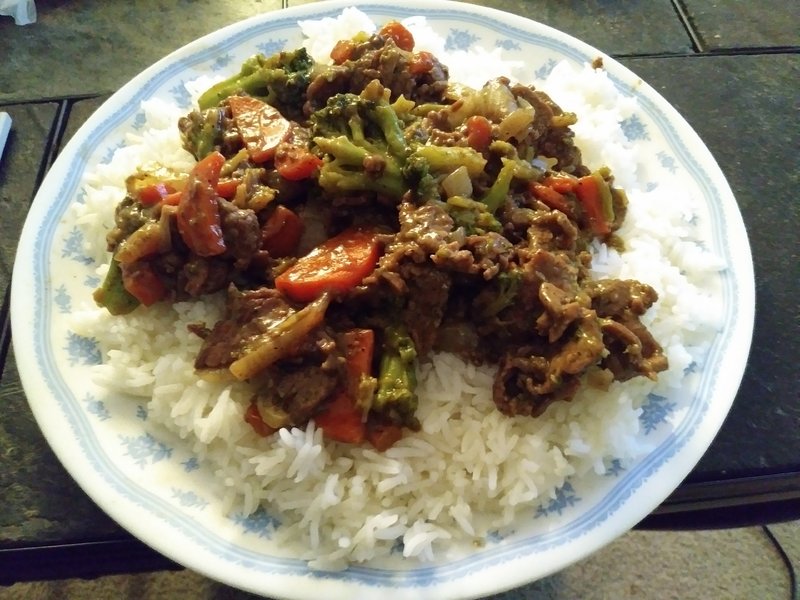Talisien
RAcast with a comedically filthy mind
- Gender
- Male
- Guildcard
- 42054495
This one is a bit long, because it's in three parts... One for the sauce, one for the dish itself, and a bit at the end for how to make the spice blend for the sauce from scratch if that's your preference.
Yellow Curry Sauce
26.66 ounces coconut milk (see Note 1, at bottom)
1.5 cups Curry Powder (see Note 2, at bottom)
8 ounces Tomato Paste
Water
Salt to taste
1.) In a large sauce pan, heat the coconut milk over low to medium heat until it begins to steam.
2.) Stir in the tomato paste until it has fully dissolved into the coconut milk.
3.) Using a whisk or fork, begin working in the Curry Powder 1/4 cup at a time. Fully incorporate each addition before adding the next.
(TIP: You're looking for a consistency like an Alfredo sauce. If, while adding the curry
powder, the sauce thickens to be closer to a paste, mix in small amounts of
water until it becomes thin enough again. Coconut milk is not consistent in the
water content, which is why this happens.)
4.) Remove from heat. If using immediately, cover with a lid; if made for freezing, allow to sit uncovered until cool to prevent unnecessary dilution of the sauce.
Curry Dinner
2 cups curry sauce
2 large potatoes
2 large carrots or parsnips
1 medium yellow onion
1 can garbanzo beans, drained and rinsed
1 lb of beef, chicken, pork, or extra-firm tofu
8 ounces of grape or cherry tomatoes, cut in half
4 ounces water (or white wine, if you want to be fancier)
(TIP: If you don't want to use meat or tofu, you can add more vegetables. Either add more of the ones in the recipe above, or experiment by adding whatever vegetables you enjoy. The less "squishy" the veggie, the better it works; cubes of squash cooked like the potatoes below are good, canned peas not so much.)
1.) Cut all vegetables, meat, and/or tofu into bite-size pieces. If using tofu, I strongly recommend pressing it thoroughly to prevent too much crumbling in the dish later on.
2.) Boil the potatoes, carrots, and/or parsnips until still firm, but you can push a fork into them. Drain and set aside.
3.)In a frying pan, over low heat, simmer the onion until it begins to become translucent.
4.) Add the meat or tofu to the onion and increase to medium heat. Cook until meat is done.
4A) If using chicken, this is the point where it has an internal temperature
of 165F/74C
4B) If using beef or pork, cooking until the meat is slightly browned will
achieve proper internal temperatures.
4C) If using tofu, simply cook until hot and some flavor from the onion
has been absorbed.
5.) Place potatoes, carrots, parsnips, and garbanzo beans into a large pot, slow cooker, or crock pot. Set to low heat.
6.) Add onions and meat or tofu to the pot.
7.) Return the frying pan used to cook the onion/meat/tofu to the heat. De-glaze, and add to pot. (see Note 3, at bottom.)
8.) Add curry sauce to the pot, gently stirring. Try to coat everything in the pot, but not break up any of your vegetables.
9.) Cover the pot and let it cook for 45 to 60 minutes.
10.) When serving, sprinkle the tomatoes across the top.
This is excellent served as-is in a bowl. To make it go further, you can also serve it over noodles or rice- both are common in several of the places around the world that curry comes from. Various breads are also quite good accompaniment: warmed naan or pita bread; focaccia, cut into 1/2" thick slices, brushed with olive oil and either grilled or toasted; a nice fluffy Italian bread with a good, chewy crust; toasted sour dough English muffins; or my personal favourite, soft sour dough pretzels (I know it's a bit weird, but it's good!)
NOTE 1: Typically, single small cans are 13.33 oz, but you can increase the total amount of coconut milk to as much as 30 ounces without hurting the rest of the measurements in the recipe.
NOTE 2: If you want, you can make your own curry powder. It's quite simple to do but it takes a lot of different spices... Though I make it from scratch for work, if I'm not trying to make a meal to impress someone I prefer to save the effort and just buy it when it's for my own personal use. Here's a basic recipe:
Curry Powder
3 teaspoons Cumin
3 teaspoons Coriander
2 teaspoons Ground Ginger
2 teaspoons Turmeric
2 teaspoons Cayenne
1 teaspoons Black Pepper
1 teaspoon Mustard Powder
1 teaspoon Ground Cardamom
1.) Put all ingredients into a spice grinder or food processor and pulse until it's all the same consistency. It'll store for months as long as it stays dry.
NOTE 3: Sorry if this is already in your skill set, I put it in just in case you're not familiar... The practice of de-glazing a pan is when you add a little bit of liquid to a hot pan you've already cooked with (and may be actively cooking in) and scrape the bottom with a spatula or spoon. The short version of why is that this loosens small bits from the bottom of the pan which mix with the liquid, creating a small amount of liquid with a lot of flavor in it to enhance the dish.
Yellow Curry Sauce
26.66 ounces coconut milk (see Note 1, at bottom)
1.5 cups Curry Powder (see Note 2, at bottom)
8 ounces Tomato Paste
Water
Salt to taste
1.) In a large sauce pan, heat the coconut milk over low to medium heat until it begins to steam.
2.) Stir in the tomato paste until it has fully dissolved into the coconut milk.
3.) Using a whisk or fork, begin working in the Curry Powder 1/4 cup at a time. Fully incorporate each addition before adding the next.
(TIP: You're looking for a consistency like an Alfredo sauce. If, while adding the curry
powder, the sauce thickens to be closer to a paste, mix in small amounts of
water until it becomes thin enough again. Coconut milk is not consistent in the
water content, which is why this happens.)
4.) Remove from heat. If using immediately, cover with a lid; if made for freezing, allow to sit uncovered until cool to prevent unnecessary dilution of the sauce.
Curry Dinner
2 cups curry sauce
2 large potatoes
2 large carrots or parsnips
1 medium yellow onion
1 can garbanzo beans, drained and rinsed
1 lb of beef, chicken, pork, or extra-firm tofu
8 ounces of grape or cherry tomatoes, cut in half
4 ounces water (or white wine, if you want to be fancier)
(TIP: If you don't want to use meat or tofu, you can add more vegetables. Either add more of the ones in the recipe above, or experiment by adding whatever vegetables you enjoy. The less "squishy" the veggie, the better it works; cubes of squash cooked like the potatoes below are good, canned peas not so much.)
1.) Cut all vegetables, meat, and/or tofu into bite-size pieces. If using tofu, I strongly recommend pressing it thoroughly to prevent too much crumbling in the dish later on.
2.) Boil the potatoes, carrots, and/or parsnips until still firm, but you can push a fork into them. Drain and set aside.
3.)In a frying pan, over low heat, simmer the onion until it begins to become translucent.
4.) Add the meat or tofu to the onion and increase to medium heat. Cook until meat is done.
4A) If using chicken, this is the point where it has an internal temperature
of 165F/74C
4B) If using beef or pork, cooking until the meat is slightly browned will
achieve proper internal temperatures.
4C) If using tofu, simply cook until hot and some flavor from the onion
has been absorbed.
5.) Place potatoes, carrots, parsnips, and garbanzo beans into a large pot, slow cooker, or crock pot. Set to low heat.
6.) Add onions and meat or tofu to the pot.
7.) Return the frying pan used to cook the onion/meat/tofu to the heat. De-glaze, and add to pot. (see Note 3, at bottom.)
8.) Add curry sauce to the pot, gently stirring. Try to coat everything in the pot, but not break up any of your vegetables.
9.) Cover the pot and let it cook for 45 to 60 minutes.
10.) When serving, sprinkle the tomatoes across the top.
This is excellent served as-is in a bowl. To make it go further, you can also serve it over noodles or rice- both are common in several of the places around the world that curry comes from. Various breads are also quite good accompaniment: warmed naan or pita bread; focaccia, cut into 1/2" thick slices, brushed with olive oil and either grilled or toasted; a nice fluffy Italian bread with a good, chewy crust; toasted sour dough English muffins; or my personal favourite, soft sour dough pretzels (I know it's a bit weird, but it's good!)
NOTE 1: Typically, single small cans are 13.33 oz, but you can increase the total amount of coconut milk to as much as 30 ounces without hurting the rest of the measurements in the recipe.
NOTE 2: If you want, you can make your own curry powder. It's quite simple to do but it takes a lot of different spices... Though I make it from scratch for work, if I'm not trying to make a meal to impress someone I prefer to save the effort and just buy it when it's for my own personal use. Here's a basic recipe:
Curry Powder
3 teaspoons Cumin
3 teaspoons Coriander
2 teaspoons Ground Ginger
2 teaspoons Turmeric
2 teaspoons Cayenne
1 teaspoons Black Pepper
1 teaspoon Mustard Powder
1 teaspoon Ground Cardamom
1.) Put all ingredients into a spice grinder or food processor and pulse until it's all the same consistency. It'll store for months as long as it stays dry.
NOTE 3: Sorry if this is already in your skill set, I put it in just in case you're not familiar... The practice of de-glazing a pan is when you add a little bit of liquid to a hot pan you've already cooked with (and may be actively cooking in) and scrape the bottom with a spatula or spoon. The short version of why is that this loosens small bits from the bottom of the pan which mix with the liquid, creating a small amount of liquid with a lot of flavor in it to enhance the dish.










